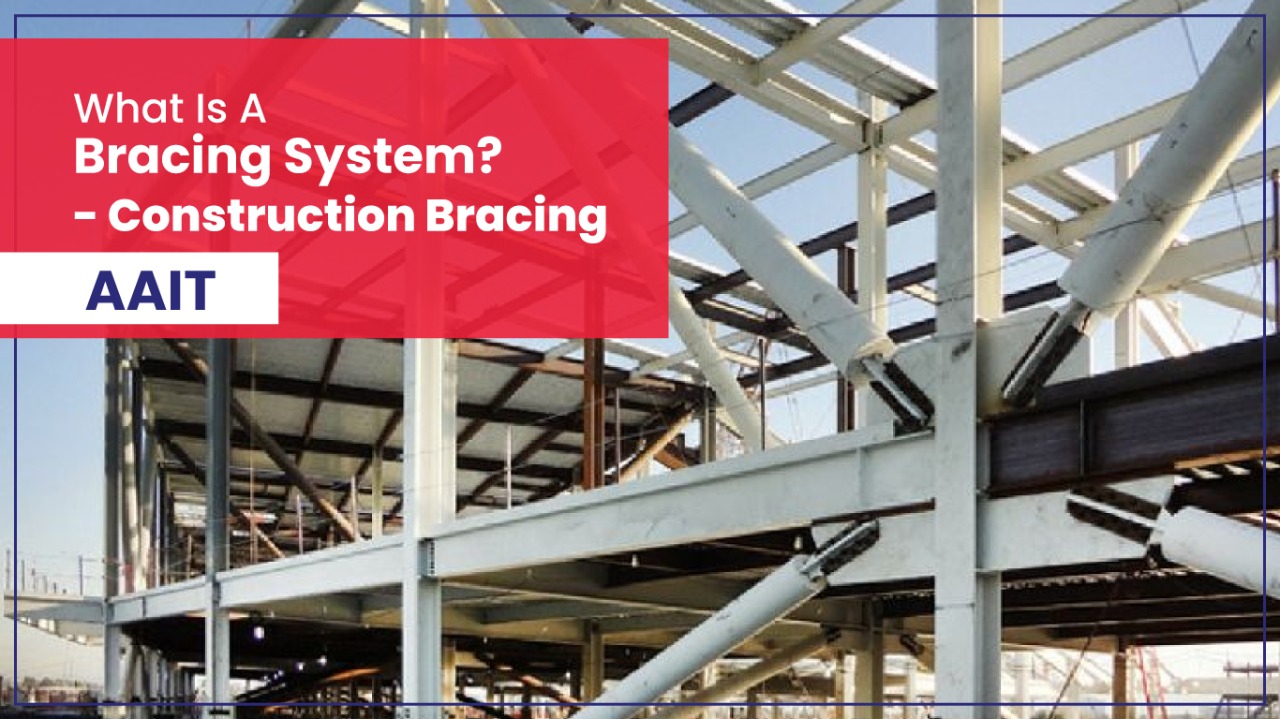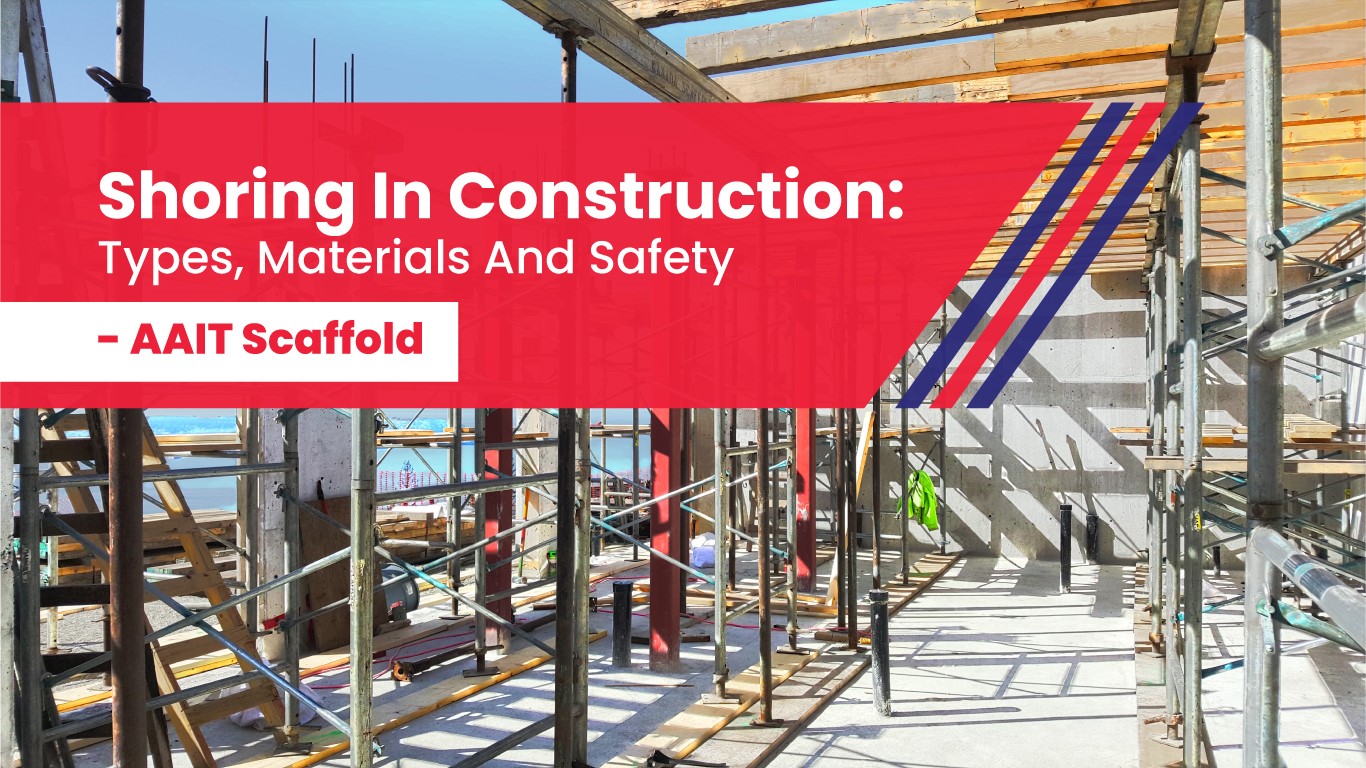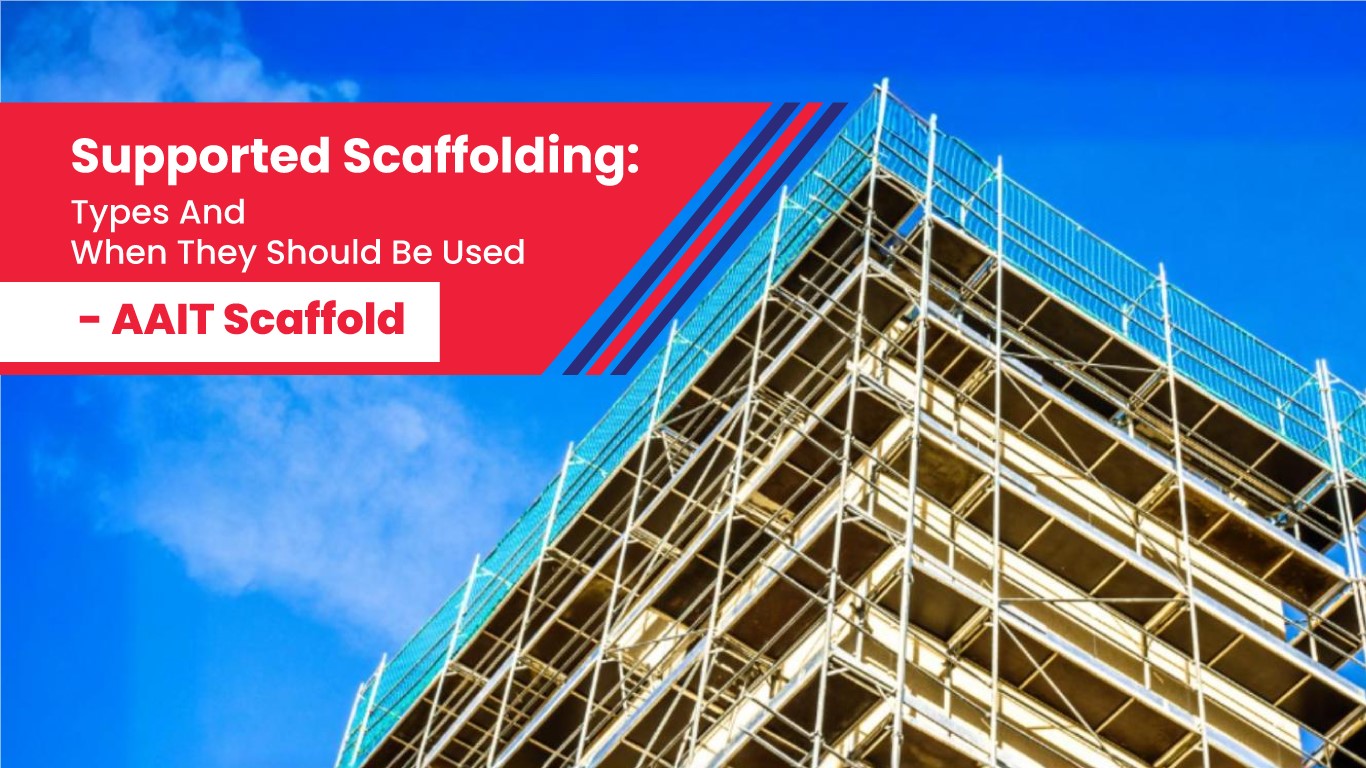What is a Bracing System? – construction bracing – AAIT
Comments Off on What is a Bracing System? – construction bracing – AAITWhen your team is busy with the execution of a project, it’s essential to offer some support to the structure. In case the structure is kept as it is, then it can collapse suddenly due to winds. People may also observe excessive swaying or deformation under stress. Lack of stability can then impact the structure’s or building’s integrity. Here’s when bracing systems can be useful. So, in this article, we shall cover more about construction bracing systems and their types.
What Is A Bracing System?
When workers are constructing modern buildings, they may use a bracing system. Such a system is designed to resist lateral forces due to the wind. It thereby prevents the structure from collapsing from different angles. Most often, the frames comprise members made from structural steel. This is because the material is known for compression and tensile strength. But, setting up a bracing system can be challenging. When team members are placing the bracing, it can perhaps impact the building’s appearance. Workers will also be unable to set up doors and windows post bracing installation.
What are the types of bracing systems?
In today’s era, you will come across many bracing types. Let’s check out the types you will usually find.
Single Diagonals
When a member is placed diagonally between two vertical elements, then it is called single diagonal bracing. Such kinds of bracing are used for small-scale projects. It provides stability due to the effective transmission of the lateral forces to the foundation.
Cross-Bracing
Under this system, workers will place two members diagonally to form an ‘X.’ Therefore, they can expect effective load distribution and an improvement in structural stability. Moreover, the resistance against lateral forces will increase when the bracing is used in high-rise buildings.
K-Bracing
In this type of construction bracing, workers place two beams diagonally. But, individuals ensure that the beams meet at the middle of a vertical member. Such a system is thus effective in preventing the deformation of the structure. Besides, workers prefer this bracing system when they have to maintain flexibility and strength.
V-Bracing
V-bracing involves placing braces diagonally to form a V shape. This means that both the braces meet at a common point of the vertical member. While this configuration offers lateral support, it also presents a large open space. It is further useful when workers have to perform tasks with minimal obstructions.
Eccentric Single Diagonals
This type of bracing system is a variant of a single diagonal system. Instead of connecting to the centre, the diagonal members are placed offset. So, when workers embrace this bracing, it enhances the efficiency of load distribution. In the long run, the structural integrity is also maintained through this bracing system. Individuals prefer this bracing only when the conventional bracing system is not ideal.
What Is The Purpose Of Construction Bracing?
Bracing is beneficial due to different reasons. Let’s check the reasons ahead.
Controls buckling of the beams
As soon as workers use bracing in certain bridges, it can prevent buckling. During the construction phase, wet concrete can cause buckling due to the applied stress. But, when bracing is set up, it can restrict lateral movement. Lateral torsional buckling will also be prevented with proper installation. Moreover, with steel bracing, the main beams will also not bend to a certain extent.
Load Distribution
Workers usually use bracing to distribute the vertical bending effect. The overall system also ensures that the impact of the wind is shared with all beams. Hence, a single beam doesn’t have to sustain the entire load. Additionally, bracing systems can offer support along the radius. This ensures safety whenever the flanges tend to become curved. The overall effects also resist the moment of forces at diverse flanges.
Dimensional Control
Whenever bracing is set up, it can control the deviations in dimensions. Deviations, conversely, may occur when the horizontal distances between girder flanges vary. This can, in turn, lead to issues during the construction phase. But, when workers introduce bracing, it can curb deviations. Having said that, the bracing shouldn’t be overloaded at any instance.
Bracing Plans: What Are They?
When you come across construction bracing plans, these are detailed documents that present the layout of the systems. Usually, the plan depicts the location of braces and the connection details. These details are required for effective support to the structure. But, to ensure quality, the contractor has to work closely with experienced draughtsmen.
Let’s now look at what you must consider for maximum performance.
- While setting up braces, workers must set them up perpendicular to one another. But, they must be positioned parallel to the exterior walls for a timber frame.
- During the installation process, the lines should be kept uniformly and with some space.
- While constructing timber-framed floors, the braces must transmit lateral loads. Moreover, the load must be transmitted along construction lines.
- When workers are busy with the setup, they must consider bracing components on the lines.
- To confirm the capability of bracing systems, individuals must carry out proper load analysis. However, the analysis can vary depending on the climatic conditions and the building’s height.
Eventually, the team must ensure that the bracing plan is compliant with the local building codes. Compliance with structural standards also needs to be maintained ahead.
Conclusion
Finally, you can contact AAIT Scaffolds when you’re planning to erect scaffolding. While the company is leading in the realm of scaffold supplies, it offers diverse services to every client. Even when we have to meet specific needs, we assure you we offer exceptional quality. With time, we also don’t fall back in offering support during project execution. Once you visit our official website, you can know more through the online catalog. Beyond everything else, we are also known to be a construction bracing supplier in the USA.
Construction Shoring: Types, Materials, and Safety
Comments Off on Construction Shoring: Types, Materials, and SafetyWhen teams execute certain construction projects, they opt for shoring. This offers the required support for the scaffold to stay in place. But, if you’re still wondering how shoring is used in construction, then read ahead. In this article, we shall cover more about the types of shoring in construction.
What is Shoring in Construction?
Whenever you come across the term, ‘shoring’, it means offering extra support to a structure. This structure can either be steel reinforcement or a scaffold. In case there’s no sufficient support, then the structure will collapse. This may occur due to loose soil and water infiltration. Way ahead, shoring has the capability of supporting heavy loads besides offering stability.
Common Construction Shoring Solutions
There are many shoring systems available in the construction sector. But, when individuals commence work, the type will depend on the requirements and the project needs. So, let’s quickly go through the most common shoring solutions.
Heavy Timber Shoring
Under this shoring, teams use timber beams to create a supportive framework. These are used for shallow excavations and medium-duty applications. While these are simple to use, they are flexible in the design.
Steel Beam Shoring
Such a shoring involves the use of steel beams to offer temporary support. The stable framework is formed by setting up vertical posts that hold the horizontal beams in place. As these offer high strength, they are ideal for deep excavations as well.
Soldier Beam Systems
When individuals set up soldier beam systems, they use horizontal beams and soldier piles. Such components are then placed at close intervals for forming a wall. This wall then stretches continuously across the area.
Types of Construction Shoring Domain
Now, let’s check out the types of shoring used for diverse purposes.
Cantilever Shoring
While installing cantilever shoring, the individuals use I-beams. This shoring is used when there’s a need for additional strength. You will observe this shoring during the construction of bridges.
Deadman Shoring
When it’s required to sustain an enormous load, people prefer deadman shoring. In addition to scaffolding systems, the shoring is used for soil retention. Most of the time, this shoring is also used when there’s less space.
Strut Shoring
While setting up this support system, workers use struts. These serve as a foundation and offer some more structural support. The shoring may also be used for keeping basement excavations in place.
Why is Construction Shoring important?
There are many reasons why people consider shoring in construction. Here are some of the reasons.
- As shoring is an essential part, it offers the required support to a scaffold. This eventually ensures safety when workers commence with the tasks.
- While these stabilize the sloping surfaces, they can also be used for excavations.
- Shoring prevents the walls from collapsing suddenly. Hence, it ensures protection for workers from unexpected accidents.
- If shoring is used properly, then it can maintain structural integrity. It can further prevent damages in the future due to certain climatic conditions.
- Ultimately, the support system ensures safety for the building.
What are the Different Types of Construction Shoring Materials?
In the construction sector, three different types of materials are used for shoring. These include aluminum, steel, and timber.
Timber Shoring
Cost-effectiveness is one of the pros of using timber shoring. But, this shoring is likely to decay when it’s in contact with the atmosphere.
Steel Shoring
Owing to its characteristics, like high strength, this shoring is quite expensive. Besides, in the case of a humid environment, this shoring doesn’t decay. The strength-to-weight ratio is also high for such a shoring.
Aluminum Shoring
An aluminum shoring is always the lightest type of shoring. But, people have to maintain the shoring regularly as it’s prone to corrosion.
How to Install and Dismantle Construction Shoring Systems?
Setting up and dismantling a shoring system is pretty straightforward. Here are the steps to follow.
- As you commence with the installation, you have to use a hydraulic lift to support the beams.
- Later, you have to use a torque wrench to make the nuts tight. In those instances, you don’t have to use any tools.
- When it’s time to dismantle the shoring, you have to make the bolts loose.
- A bit later, you need to unmount the jacks from every beam.
So, only with the help of an experienced person supervising all shoring applications, this can be set up easily.
Regulations and Standards for Shoring in Construction
To ensure the structure’s safety, you have to comply with some regulations. These include those under The International Building Code. Regulations under OSHA also have to be taken into account.
The International Building Code (IBC)
The IBC covers a few standards that are stated by the International Code Council. These present the requirements in detail regarding shoring designs. Workers can also get a clear idea about how the shoring has to be maintained. Some of the standards are also pertaining to load testing. For instance, if a group of engineers has to carry out some tests, then they can refer to the standards.
Construction Shoring Regulations
With time, the OSHA has laid down some guidelines for the safe use of shoring. These state the duration for which workers can stay safe during diverse projects. With the help of the ladder, workers can also access areas at different levels. Above all, guardrails have to be set at more than 4 feet. This will prevent objects from falling while the work is in progress. Exit routes will also be offered in case the workers have to leave the area quickly.
Conclusion
Finally, shoring has always been established for construction projects. Apart from supporting the structure’s weight, shoring creates a strong foundation. But many factors have to be considered before choosing shoring. Firstly, the individuals have to know more about the load-bearing capacity. They also have to evaluate the structure’s weight. This, in turn, will ensure safety for the project.
Are you planning to set up a scaffold? Well, in that case, you can connect with AAIT Scaffolds that offer scaffolding parts in USA.
supported scaffold : Types and When They Should Be Used
Comments Off on supported scaffold : Types and When They Should Be UsedIn today’s world, you may have come across scaffolding at many instances. This is nothing but a temporary structure that enables workers to work at different heights. In the past, the scaffold components were made from bamboo or wood. But, now the scaffolding is durable because the components are made from strong materials. So, in this article, we shall cover more about supported scaffolding and its applications.
What is Supported Scaffolding?
In the construction domain, supported scaffolding is a temporary structure that offers a stable platform. Such a platform is supported by vertical posts, which are secured to the ground for stability. As the scaffold is used for tasks like painting or repairs, individuals can work at different heights. Moreover, with the use of safety accessories such as nets and braces, workers can ensure safety. After completion of tasks, the scaffold is dismantled so that it can be used again. Now, let’s check out the types of supported scaffolding.
Supported Scaffolding Types
At diverse sites, you will come across many supported scaffolding types. So, let’s go through the types in detail.
Frame Scaffolding
Many teams at construction sites commonly use frame scaffolding. This is because these are affordable and easier to use. Mostly, such scaffolds have a base with feet that can be secured into the ground. The entire modular design can also enable workers to work at different heights. They can further carry out construction and maintenance tasks owing to the scaffold’s strength and versatility.
Tube and Coupler Scaffolding
As the name suggests, these scaffolds are erected using scaffold tubes and clamps. Once the workers start setting up the scaffold, they will use coupling devices. Eventually, these scaffolds are extremely versatile because they can assemble the way you want. But, certain steps have to be followed to erect the scaffold safely.
System Scaffolding
This type of scaffold has safety features like guard rails and barricades. Once everything is installed properly, the risk of accidents is reduced. Whenever you observe this scaffold, workers use ladders for climbing up or down. Primarily, you will come across Kwikstage scaffolding and Cuplock scaffolding under this type.
Ladder Jack Scaffolding
Among the types of supported scaffolding, this scaffold is commonly used. While these rest on a platform supported by brackets, they can be erected with ease. Way ahead, workers use the scaffold in different scenarios. Owing to the minimalism, the scaffolds are also suitable when less load has to be sustained.
Pump Jack Scaffolding
This scaffold features a moveable platform with poles set vertically. The temporary structure is also adjustable, as the brackets can be lowered or raised. Hence, construction teams use this scaffold simply because it can be customized. On the other hand, the scaffold is affordable compared to other types.
Mobile Scaffolding
Painters often use mobile scaffolding because it can be moved anywhere along its wheels. Further ahead, the scaffold is suitable when workers have to set different positions at the site. Apart from painting, the mobile scaffold is also used when a building is undergoing renovation. Workers may also prefer using this scaffold when they have to carry out plastering work.
When Should Each Type Be Used?
As you catch a glimpse of every type of supported scaffold, it is used for a certain purpose. Frame scaffolding is usually used for maintenance work and renovations. In case you want to erect the scaffold in a desired form, then tube and coupler scaffolding is suitable. In contrast, when the structure has to be adjusted time and again, workers use a pump jack scaffold. However, if the tasks have to be carried out across a large area, then you will observe a mobile scaffold. To ensure maximum safety, teams may also use a system scaffold.
Benefits of Using the Right Supported Scaffolding
Whenever you use suitable supported scaffolding, it offers many benefits.
Enhanced Safety
Proper scaffolding always ensures that the workers can use a stable platform. Installing toeboards and guardrails can further help to make the working environment quite safe.
Increased Efficiency
With the installation of suitable scaffolding, workers can carry out tasks with ease. As soon as the workers are swift with the tasks, you can also perceive improved productivity.
Versatility
When you use a suitable scaffold system, it can be adapted to diverse construction tasks. You can also customize the scaffold as per your needs regardless of the work.
Cost-Effectiveness
Considering the right type of scaffold can mitigate the need for costly repairs. You will also not have to bear financial repercussions because the risk for accidents is minimized.
In the end, you will not be in deep trouble when you choose a suitable scaffold. As the project proceeds ahead, the industry standards and safety regulations are always met.
Supported Scaffolding Safety Tips
Safety is always crucial when workers are using a supported scaffold. So, let’s go through some tips.
- Before you think about erecting a scaffold, you must inspect it thoroughly. During the inspection, you must check for loose bolts or missing components.
- Always get in touch with trained professionals to assemble the scaffold properly. Once the temporary structure is set up, you must make sure that the components are properly connected.
- When workers are concerned about sudden accidents, you must install guardrails and toeboards. Such components will certainly prevent individuals from falling suddenly.
- After installing the scaffold, you must follow certain weight limits. This will ensure that the scaffold is not overloaded with workers or materials.
- As soon as you think about erecting a scaffold, make sure that it’s away from the power lines. In case the scaffold is closer to the power lines, then it may lead to accidental electrocution. In addition, you must make sure that the scaffolding materials are non-conductive.
Eventually, workers must use personal protective equipment while climbing or descending the scaffold. By wearing such equipment, workers can manage everything without the occurrence of accidents.
Why Choose Reliable Commercial Scaffolding?
Choosing reliable commercial scaffolding is vital to ensure the success of projects. When the scaffolding is of high quality, it can reduce the risks of accidents. The temporary structure can also sustain heavy loads with a design that meets safety standards. As the scaffold lasts long, workers don’t have to bother about repairs. Additionally, investing in commercial scaffolding solutions means complying with local regulations. Workers will also be able to perform the tasks smoothly with a stable platform beneath.
Conclusion
Finally, if you’re still unsure which scaffold to use, then connect with some professionals. However, you can contact a supported scaffolding supplier in the USA, AAIT Scaffold, for accessories and parts. While our team will be more than happy to serve you, we will ensure that your concerns are met.












 Download
Download

